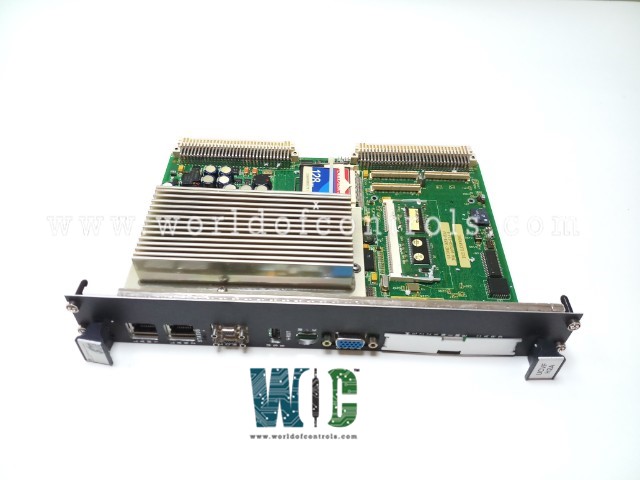
World Of Controls understands the criticality of your requirement and works towards reducing the lead time as much as possible.
IS215UCVFH2A - VME Processor Control Card, 850 MHz is available in stock which ships the same day.
IS215UCVFH2A - VME Processor Control Card, 850 MHz comes in UNUSED as well as REBUILT condition.
To avail our best deals for IS215UCVFH2A - VME Processor Control Card, 850 MHz, contact us and we will get back to you within 24 hours.
SPECIFICATIONS:
Part Number: IS215UCVFH2A
Manufacturer: General Electric
Series: Mark VI Innovation Series
Microprocessor: Intel Pentium III 850 MHz
Memory: 32 MB DRAM
Operating System: QNX
Programming: Boolean
Operating Temperature: 0 to 50 Deg C
Primary Ethernet interface (Ethernet 1): Twisted pair 10BaseT/100BaseTX, RJ-45 connector
Secondary Ethernet interface (Ethernet 2): Twisted pair 10BaseT/100BaseTX, RJ-45 connector
Product Type: Controller Board
Power requirements: UCVFH2 +5 V dc, 6 A typical, 7 A maximum
Availability: In Stock
Repair: 3-7 Days
Country/Region of Manufacture: United States
Manual: GEI-100603A
FUNCTIONAL DESCRIPTION:
IS215UCVFH2A is a VME Processor Control Card, 850 MHz manufactured and designed by General Electric as part of the Mark VI innovation series VME platform used in gas turbine control systems. The UCVF is a double-slot board using an 850 MHz Intel Pentium III processor with 16 MB of flash memory and 32 MB of DRAM. Two 10BaseT/100BaseTX (RJ- 45 connector) Ethernet ports provide connectivity to the toolbox or other control devices. The second Ethernet on the UCVF is for use on a separate IP logical subnet. The configuration of the second Ethernet port is performed through the toolbox. The controller validates its toolbox configuration against the existing hardware each time the rack is powered up.
The top-of-the-line current-generation controller, the double-slot UCVF, is only utilized in systems that need it. The single-slot UCVG can be used to directly replace any prior controller version without the need for a backplane upgrade and offers performance comparable to the UCVE and UCVF. The UCVF can also take the place of controllers from older revisions, however, this requires a backplane upgrade. A 10Base2 to 10Base-T Ethernet cable upgrade is also necessary when replacing a UCVB.
SPECIAL FEATURES FOR EMBEDDED APPLICATIONS:
STANDARD FEATURES INCLUDE:
MICROPROCESSOR:
The VMIVME-7740 brings the Intel Pentium III processor to VMEbus, offering processor speeds up to 850 MHz. The Pentium III processor has 32-bit addressing and a 64-bit data bus. Its superscalar architecture allows three instructions to be executed per clock cycle. A dynamic branch prediction unit, separate instruction and data caches, and MMX™ technology also increase the processor’s performance. The Pentium III processor also provides 256 K byte of advanced transfer cache (on-die, full speed level 2 cache) using dual independent bus architecture for high bandwidth and performance. This L2 cache operates at the same clock frequency as the processor, thus improving performance.
WOC has the largest stock of OEM Replacement Parts for GE Innovation Series Turbine Control Systems. We can also repair your faulty boards and supply unused and rebuilt boards backed up with a warranty. Our team of experts is available around the clock to support your OEM needs. Our team of experts at WOC is happy to assist you with any of your automation requirements. For pricing and availability on parts and repairs, kindly contact our team by phone or email.
What does the 850 MHz clock speed indicate?
The 850 MHz clock speed represents the processor’s operating frequency, which defines how many cycles it executes per second. It influences the card’s data throughput and processing capabilities, making it suitable for medium- to high-performance real-time systems.
Which processor architecture is typically used?
Most 850 MHz VME processor cards use PowerPC or ARM architecture, known for their performance and energy efficiency in embedded systems. These architectures are optimized for real-time operations and often include floating-point units and vector processing support.
Which operating systems are compatible with the card?
VME processor cards are typically compatible with real-time operating systems such as VxWorks, QNX, and real-time Linux. Some may also support embedded Windows variants or proprietary OSs, depending on firmware and board support packages (BSPs).